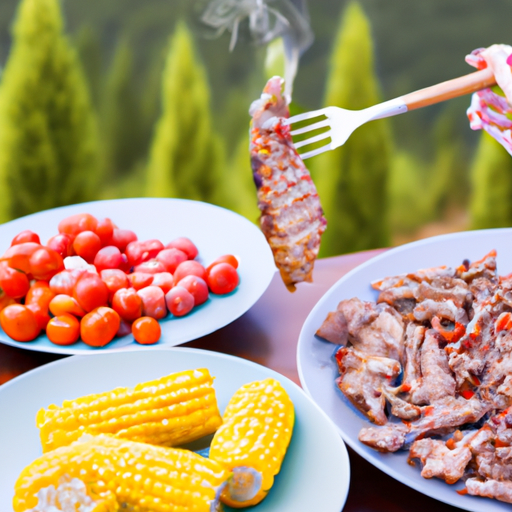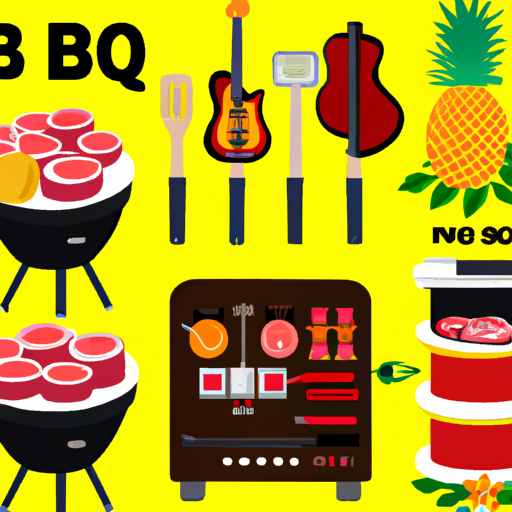Imagine never having to worry about overcooking or undercooking your favorite meats on the grill again. With “The Ultimate BBQ Cooking Chart,” you’ll have a foolproof guide right at your fingertips. This innovative product provides you with precise cooking times and temperatures for a wide variety of meats, ensuring perfectly grilled perfection every time. Gone are the days of guessing and hoping for the best. Whether you’re a seasoned grill master or a novice just starting out, this cooking chart will revolutionize your grilling experience. Get ready to impress your family and friends with your perfectly cooked BBQ creations.
The Ultimate BBQ Cooking Chart
When it comes to cooking, there is nothing quite like barbequing. The smoky flavors, the mouthwatering aroma, and the joy of gathering around a grill with friends and family – it’s an experience that can’t be beat. But to make the most of your BBQ adventures, it’s important to have the right knowledge and tools. That’s where the Ultimate BBQ Cooking Chart comes in. In this comprehensive guide, we’ll cover everything you need to know about BBQ cooking methods, equipment, temperatures, times, techniques, safety tips, marinades and rubs, side dishes, and how to cater to special diets. So grab your tongs and let’s get grilling!

1. Types of BBQ Cooking Methods
Before we dive into the nitty-gritty details, let’s start with the basics: BBQ cooking methods. There are a few main techniques when it comes to barbequing, each with its own unique qualities and flavors. The most common methods include grilling, smoking, and indirect cooking. Grilling is the fastest and most direct method, where food is cooked directly over the heat source. Smoking, on the other hand, involves slow cooking food over indirect heat, usually with wood chips to infuse a smoky flavor. And then there’s indirect cooking, which is a combination of both grilling and smoking, where the heat source is placed to the side of the food for a slower, more evenly cooked result. Each method has its own advantages, so choose the one that suits your taste and style of cooking.
2. Choosing the Right BBQ Cooking Equipment
Now that we’ve covered the different cooking methods, let’s talk about choosing the right BBQ cooking equipment. The right tools can make a world of difference in your barbequing experience. First and foremost, you’ll need a reliable grill. There are various types of grills available – from charcoal and gas grills to electric and pellet grills. Consider factors such as convenience, flavor preferences, and budget when making your decision. In addition to the grill, you’ll need essential accessories like tongs, spatulas, skewers, and a meat thermometer. Don’t forget about cleaning tools, as proper maintenance of your grill is crucial for longevity and optimal cooking results. Invest in a high-quality grill brush and scraper to keep your grill in top shape.
3. BBQ Cooking Temperatures
Achieving the perfect BBQ cooking temperatures is key to cooking your food to perfection. Different types of meats and dishes require specific internal temperatures to ensure they are cooked safely and deliciously. For example, poultry like chicken and turkey should reach an internal temperature of 165°F (74°C), while beef steak can be enjoyed at various levels of doneness, such as medium-rare at 135°F (57°C) or medium-well at 150°F (66°C). A meat thermometer is an invaluable tool to accurately measure the internal temperature of your food. Make sure to refer to a BBQ cooking temperature chart for a comprehensive guide on safe and tasty cooking temperatures for various meats and dishes.
4. BBQ Cooking Times
Alongside the right temperatures, knowing the appropriate BBQ cooking times is essential for achieving succulent and perfectly cooked food. The cooking time will vary depending on factors like the type of meat, thickness, desired level of doneness, and cooking method. For example, a 1-inch thick steak cooked to medium-rare will take approximately 4-5 minutes per side on a hot grill. Conversely, larger cuts of meat, like a whole chicken, may require longer cooking times of around 1.5-2 hours when using indirect heat. It’s important to be aware of these cooking times to avoid undercooking or overcooking your dishes. Keep an eye on your food and utilize a timer to ensure your BBQ creations turn out just right.

5. BBQ Cooking Techniques
To elevate your BBQ game and add variety to your dishes, it’s worth exploring different BBQ cooking techniques. While simply grilling your food can provide delicious results, incorporating techniques like searing, smoking, and indirect grilling can take your flavors to the next level. Searing involves quickly cooking meats at high heat to create a flavorful crust while preserving the juiciness inside. Smoking adds a unique smoky taste through the use of wood chips or chunks and requires longer cooking times for that distinctive BBQ flavor. Indirect grilling is perfect for slow-cooking tougher cuts of meat or creating smoked flavors without the intense heat. Experimenting with these techniques will allow you to expand your BBQ cooking repertoire.
6. BBQ Cooking Safety Tips
When engaging in any form of cooking, safety should always be a top priority. BBQ cooking is no exception. To ensure a safe and enjoyable grilling experience, follow these essential BBQ cooking safety tips. First and foremost, always cook in a well-ventilated outdoor area to prevent the buildup of harmful carbon monoxide. Keep a fire extinguisher nearby, just in case of any mishaps. It’s crucial to regularly clean your grill to prevent grease buildup, which can lead to flare-ups. Practice safe food handling by using separate utensils and cutting boards for raw and cooked foods to avoid cross-contamination. Lastly, keep children and pets away from the grill area to prevent accidents. By prioritizing safety, you can grill with peace of mind.
7. BBQ Cooking Marinades and Rubs
One of the best ways to add flavor and enhance the juiciness of your BBQ dishes is through marinades and rubs. Marinades are liquid mixtures typically composed of acid, oil, herbs, spices, and other flavorful ingredients. They are used to tenderize and infuse flavors into meats, vegetables, and even tofu for vegetarian options. Marinate your food for at least 30 minutes or up to overnight before grilling for maximum flavor penetration. On the other hand, rubs are dry mixtures consisting of spices, herbs, salt, sugar, and other ingredients. They create a flavorful crust on the exterior of your food during the cooking process. Experiment with different marinades and rubs to find your favorite flavor combinations and elevate your BBQ creations.
8. BBQ Cooking Side Dishes
While the main focus of a BBQ may be the grilled meats, don’t forget about the delicious side dishes that complement and complete the meal. From classic choices like coleslaw, baked beans, and corn on the cob to more adventurous options like grilled vegetable skewers and stuffed mushrooms, the possibilities are endless. Experiment with different recipes and flavors to find the perfect sides that balance and enhance your BBQ dishes. Consider including a variety of textures and tastes to cater to different preferences. With the right side dishes, you can create a well-rounded BBQ feast that will leave your guests satisfied and impressed.
9. Vegetarian BBQ Cooking
BBQ cooking isn’t just limited to meat lovers – there are plenty of tantalizing options for vegetarians too. Grilled vegetables, tofu, halloumi cheese, and plant-based burgers are just a few examples of delicious meat alternatives that can be cooked on the grill. The trick to successful vegetarian BBQ cooking lies in marinating and seasoning your vegetable or plant-based protein of choice to enhance its flavor profile. Grilling veggies like peppers, zucchini, and corn can bring out their natural sweetness and create a smoky taste. Remember to use a clean grill surface or a grill basket to prevent any cross-contamination with meat drippings. Vegetarian BBQ cooking can be just as satisfying and flavorful as traditional meat-focused barbequing.
10. BBQ Cooking for Special Diets
Last but certainly not least, let’s talk about BBQ cooking for special diets. Whether you or your guests have dietary restrictions or preferences, it’s important to consider their needs when planning a BBQ gathering. For those following a gluten-free diet, ensure that all marinades, rubs, and sauces are free from wheat or gluten-containing ingredients. Vegans can enjoy BBQs too by opting for plant-based proteins and vegetable-focused dishes. Make sure to have a separate section of the grill for vegan or vegetarian options to avoid cross-contamination. If someone has allergies, be mindful of potential allergens and cross-contamination risks, and communicate about ingredients to ensure everyone’s safety. By catering to special diets, you can create a inclusive and enjoyable BBQ experience for all.
In conclusion, the Ultimate BBQ Cooking Chart provides a comprehensive guide to all aspects of barbequing – from cooking methods and equipment to temperatures, times, techniques, safety tips, marinades and rubs, side dishes, and catering to special diets. Armed with this knowledge, you can confidently embark on your BBQ adventures and impress your guests with mouthwatering creations. So fire up that grill, savor the smoky flavors, and enjoy the joyous experience of barbequing with friends and family. Happy grilling!
